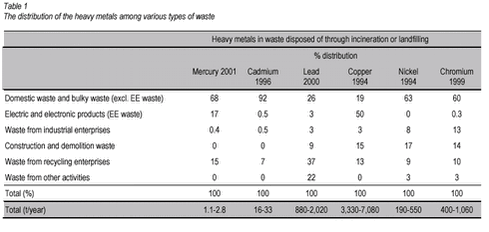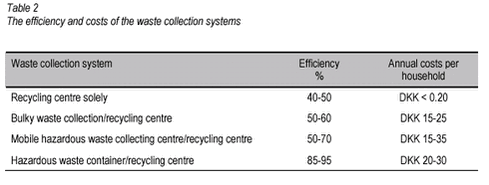Heavy Metals in Waste Summary and ConclusionsHeavy metals are used everywhere in society and found in waste from households and most types of enterprises. This guide addresses municipalities and waste management companies. The guide provides instructions on how to identify heavy metals in waste, and ideas on how to achieve a higher degree of sorting and recycling of heavy metals. This guide can also be used in connection with the preparation of municipal waste regulations and waste collection systems. Initially, the guide describes the waste types in which each of the heavy metals mercury, cadmium, lead, copper, nickel and chromium can be found, as well as the size of the quantities. Subsequently the sources of the heavy metals in household and industrial waste are described. The guide comprises instructions for 16 types of enterprises: Metal-processing enterprises, plastics-processing enterprises, carpenters/joiners, plumbing and heating firms, plumbers and locksmiths’ shops, electricians, bricklayers , damage services, demolition enterprises, scrap dealers, electronics scrap dealers, cable-processing enterprises, sorting plants, garages, fishery, hospitals and dental clinics. For each type of enterprise there are instructions on how heavy metals can be found in the waste specific to the type of firm in question, and ideas on how to improve waste management. The specific instructions on how to locate the heavy metals, and how they can be managed, are supplemented by ideas on how the municipalities could increase the recycling of heavy metals by means of e.g. waste plans, waste regulations, waste systems and waste solutions.
Household waste As appears from table 1, a substantial proportion of waste containing heavy metals is produced by households. In addition to "domestic waste and bulky waste" in the table, some of the electrical and electronic products and construction waste may be processed in the ordinary domestic waste or bulky-waste systems. In the survey, seven alternative collection systems were identified, of which four are discussed in detail: recycling centre solely, bulky waste collection/recycling centre, mobile hazardous waste collecting centre/recycling centre and hazardous waste container/recycling centre (see table 2). Recycling centre solely is considered the most flexible method for increased collection of waste containing heavy metals. The system is, however, constrained by the fact that not all citizens are able to utilize the centre. On the basis of the calculations, it is relevant for the municipalities to consider a solution in which the recycling centre is the only disposal possibility (relatively high collection efficiency compared to the cost), or a solution in which there is access to the recycling centre combined with household collection via a hazardous waste container (very high collection efficiency with correspondingly high costs). The hazardous waste container would of course be applicable for other types of hazardous waste. Although products made of brass and stainless steel contain copper, nickel and chromium that would be hazardous if they were later released into the environment, these products are often considered environmentally unproblematic, as they can be managed without any serious problems. Thus it may be required to distribute the information that heavy metals in the waste flow are undesirable.
Collection systems for managing waste from enterprises As regards manufacturing enterprises, waste containing heavy metals is primarily produced in metal-processing companies and companies producing or processing hard PVC. The majority of the waste in the form of metal shavings, metal cuts etc. is recycled. What is left is in the form of sweepings, dust catchers, residues on abrasive belts etc. In certain types of company, e.g. companies processing stainless steel, the quantity of heavy metals disposed of with metal waste for incineration is often quite significant. Thus there is a need to develop collection solutions that can reduce the fine metal waste transferred to incineration and other waste disposal. In connection with tradesmen it is important that enterprises can dispose of waste from electrical and electronic products and mixed-metal waste that cannot immediately be sold to scrap dealers. It is important that small enterprises have access to the municipal recycling centres, and that the enterprises can be connected to the mobile collection systems for hazardous waste. For combustible products which contain metal parts, there is a need to develop methods for removal of the metal parts from the waste. |

